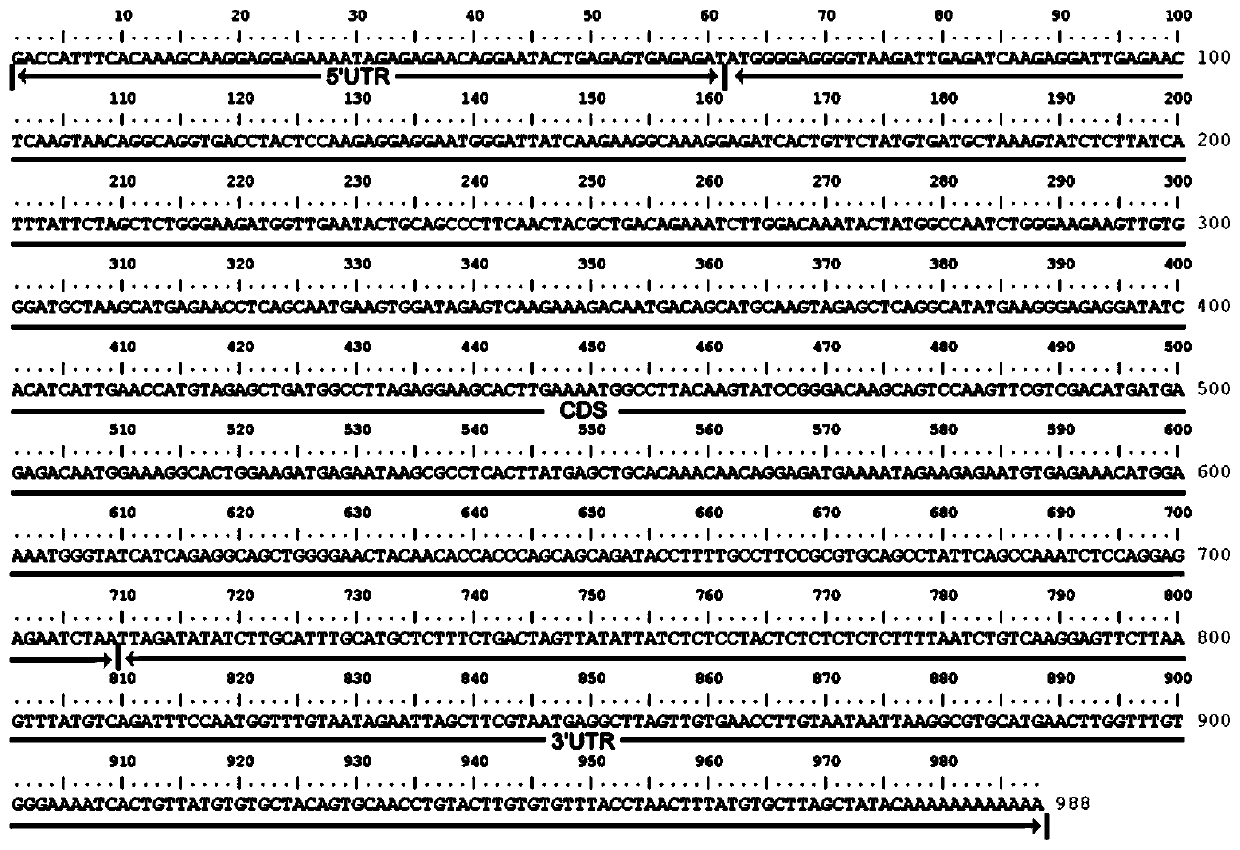Loquat flower organ development related transcription factor EjPI protein and coding gene and application thereof
A technology of loquat and protein, applied in the fields of application, genetic engineering, plant gene improvement, etc., to achieve good application prospects and improve ornamental effect
- Summary
- Abstract
- Description
- Claims
- Application Information
AI Technical Summary
Problems solved by technology
Method used
Image
Examples
Embodiment 1
[0024] Cloning of embodiment 1 loquat EjPI gene cDNA sequence
[0025] Extraction of Total RNA from Loquat Flower Buds
[0026] Collect fresh loquat flower buds with a length of about 1.0 cm, quickly put them into cryopreservation tubes, freeze them in liquid nitrogen for 3 hours, and put them in a -80°C ultra-low temperature freezer for later use. Use the RNA extraction kit to extract the total RNA of flower buds: take out the flower bud materials from the -80°C ultra-low temperature refrigerator, put them into a mortar that has been frozen in advance and add 2 mL of RLT lysate and 200 μL of PLANTaid, and grind them thoroughly at room temperature; Transfer the grinding solution to a 2mL eppendorf centrifuge tube, centrifuge at 13000rpm for 15min, absorb 500μL of the supernatant, and transfer it to a new 2mL centrifuge tube; add 250μL of absolute alcohol to the supernatant, mix well by pipetting, and then add it to the adsorption column , and put the adsorption column into th...
Embodiment 2
[0037] Semi-quantitative RT-PCR expression analysis of embodiment 2 loquat EjPI gene
[0038] Total RNA was extracted from loquat sepals, petals, filaments, anthers, and pistils, and after removing trace amounts of DNA in the total RNA, it was reverse-transcribed into cDNA. According to loquat cDNA as a template, oligo 6.0 software was used to design semi-quantitative RT-PCR primers RTEjPIF: 5'-TGCTAAGCATGAGAACCTCAGCAATGA-3' and RTEjPIR: 5'-CAGCTGCCTCTGATGATACCCAT-3'. Use PCR to test its specificity, and semi-quantitative RT-PCR experiments can only be carried out under the premise of ensuring PCR-specific amplification. The loquat actin gene was used as an internal reference gene, and the primers were RTEjactinF: 5'-AATGGAACTGGAATGGTCAAGGC-3' and RTEjactinR: 5'-TGCCAGATCTTCTCCATGTCATCCCA-3', and PCR amplification was performed, with 3 biological replicates for each reaction. The PCR reaction program was: pre-denaturation at 94°C for 5min; 25 cycles at 94°C for 30s, 55°C for ...
Embodiment 3
[0039] The plant transgenic vector pBI121-EjPI construction of embodiment 3 loquat EjPI gene
[0040] PCR amplification was used to introduce restriction sites at both ends of the CDS region of the loquat EjPI gene. Using the reverse transcribed cDNA of loquat flower bud total RNA as a template, TEjPI-F: 5′- TCTAGA ATGGGGAGGGGTAAGATTGAGATCA-3′(introduce XbaⅠ restriction site) and TEjPI-R: 5′- CCCGGG TTAGATTCTCTCCTGGAGATTTGG-3' (introduced SmaI restriction site) was used as primer, and EX-taq enzyme was used for PCR amplification. PCR reaction program: 94°C for 4min; 30 cycles of 94°C for 45s, 57°C for 45s, and 72°C for 45s; 72°C for 10min. After the reaction, the PCR products were subjected to 1% agarose gel electrophoresis and recovered using an agarose gel DNA recovery kit. The recovered PCR product was connected to the pMD19-T vector, and transformed into E. coli competent cells. After single clones were picked, they were sent for sequencing. According to the sequenci...
PUM
 Login to View More
Login to View More Abstract
Description
Claims
Application Information
 Login to View More
Login to View More - R&D
- Intellectual Property
- Life Sciences
- Materials
- Tech Scout
- Unparalleled Data Quality
- Higher Quality Content
- 60% Fewer Hallucinations
Browse by: Latest US Patents, China's latest patents, Technical Efficacy Thesaurus, Application Domain, Technology Topic, Popular Technical Reports.
© 2025 PatSnap. All rights reserved.Legal|Privacy policy|Modern Slavery Act Transparency Statement|Sitemap|About US| Contact US: help@patsnap.com



